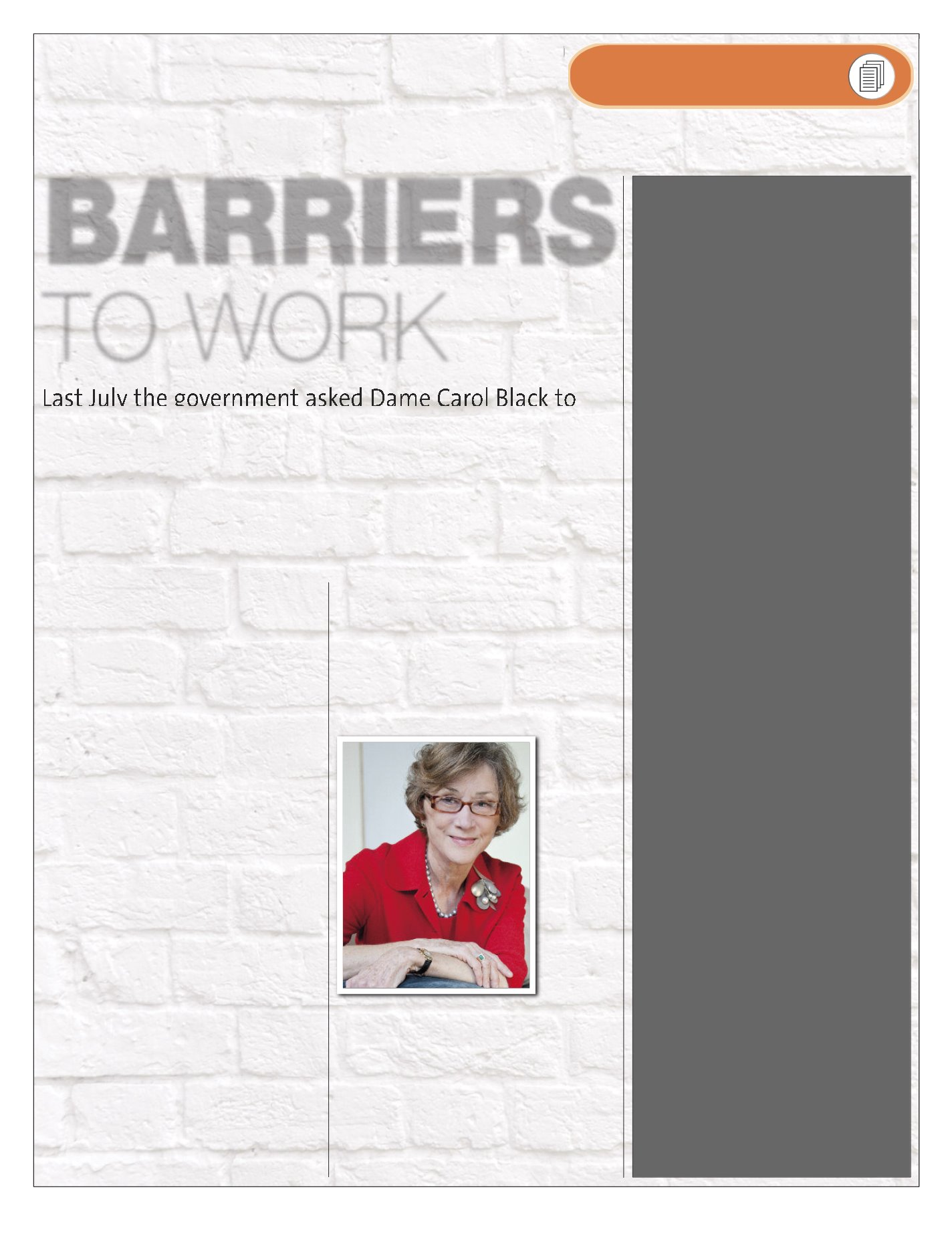
Parliamentary GrouP
more about support to work:
‘Employers told us that the
government needs to de-risk
it for them... They wanted a
support person on the end
of the phone.’
DamE Carol BlaCk
also about employers, who were ‘the last part of the
jigsaw’.
‘Employers told us that the government needs to
de-risk it for them,’ she said. ‘They wanted a support
person on the end of the phone, so we’ve made
recommendations on how the government might
work with employers… unless we can get employers
on board, it won’t matter how good treatment is.’
‘I
’ve put drugs and alcohol in part one of the
report and obesity in part two, as the challenges
are quite different,’ Dame Carol Black told the
parliamentary group. ‘We looked internationally,
talked to as many stakeholders as possible and visited
prisons and treatment centres.’
The first job was to get a handle on numbers, as we
often didn’t hear about people having problems until
they were in the benefit system with another problem,
such as mental health issues or anxiety, she explained.
‘People worry that a specific problem might
disadvantage them, so they may have something else
as the primary diagnosis from their GP, such as mild
depression,’ she said. Many people with addiction
might have other problems such as diabetes, which
needed attention before they could work.
So the first problem was identification and sharing
data, and the review would contain recommendations
on improving this.
One of the motives for the review was to find out if
there was a viable case for a mandatory route to
treatment, carrying a penalty of reduced benefits. This
was rejected by Black, as ‘there is no evidence that
being in treatment gets you anywhere nearer to the
labour market’. We needed to have conversations
about barriers to work, so that work became a part of
treatment, she said.
The report would also identify lack of activity as
terrifying for those in recovery who had been
permanently busy finding their next fix of drugs.
Environment was another problem, said Black: ‘After
treatment they would go back to friends and the
environment they’re trying to get away from. They
need to be housed away from addicts, but taking them
away from former friends and family is very difficult.’
Many wanted ‘a home, partner, work and, if poss-
ible children, – but they know how difficult that is’.
The report would make recommendations about
getting work into the treatment environment – and
Last July the government asked Dame Carol Black to
conduct an independent review into the challenges of
getting and staying in work for people with drug and
alcohol problems, or who are obese. With her report
imminent, she gave a preview to the Drugs, Alcohol and
Justice Parliamentary Group. DDN reports
BARRIERS
TO WORK
16 |
drinkanddrugsnews
| May 2016
REACTIONS FROMTHE GROUP…
‘HELP PEOPLE TEST THE WATER’
‘Taking a holistic view of people’s lives is important.
People aren’t necessarily going to be ready for
employment if they have health or housing issues.
Practical things that can be done are helping
people to get to and from interviews and meetings
and help with building life skills. It’s hard to provide
time to do this in the treatment sector.
‘We’d also like to see support pre and post
employment, so there’s a much more joined-up
connection. We’re keen on any support that could
be made with local employers to move people
through the system and help them test the water.’
Karen Tyrell, Addaction
‘WE WILL SEIZE THE OPPORTUNITY’
‘The treatment system will commit to you and
DWP to do our best. The focus has been on crime,
harm reduction, then recovery. Then there was
the crash, and the agenda moved on. We will try
to seize this opportunity to make this work.’
Paul Hayes, Collective Voice
‘WILL INFORMATION SHARING BE SAFE?’
‘One of the things that was concerning me was the
information sharing. How would you educate
people that they wouldn’t be at a disadvantage, and
that if they did disclose, it would go in their favour?’
Kirstie Douse, Release
Dame Carol Black replied
: ‘We can’t go on as we
are – in a safe and secure way we need to get
that data and know what people’s health
problems are. If we continue with a mismatch of
data we’re not going anywhere. People think it
might affect their benefits, but there has to be a
safe way of doing this.’
‘THE SYSTEM IS SET UP TO BLAME PEOPLE’
‘Stigma is one of the biggest barriers to
employment. People who are stigmatised start to
believe the message themselves. The whole
system is set up to blame people for not being in
work. Two thirds of employers would be unwilling
to help them.
‘It can be a slow journey, with personality or
behavioural disorders and a wide range of physical
and mental health illnesses. We did a survey and
the barriers to getting back to work included lack
of confidence, lack of computer skills and poor
health. Age was also a factor for many.
‘We need specialist help and in-reach, and unless
you get these right, nothing’s going to happen.’
John Jolly, Blenheim


